
Annual Bulletin 5, 1981-1982
Home
Français
Introduction
History
Annual Index
Author &
Subject
Credits
Contact

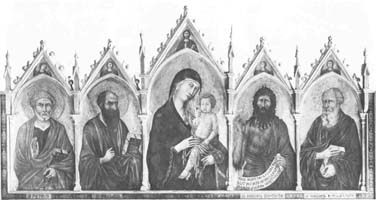
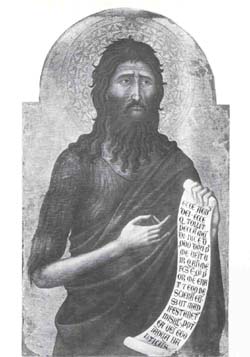
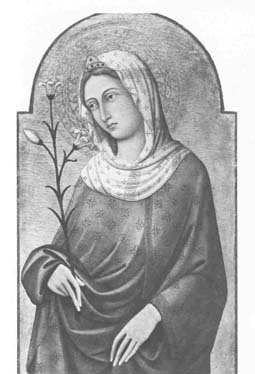
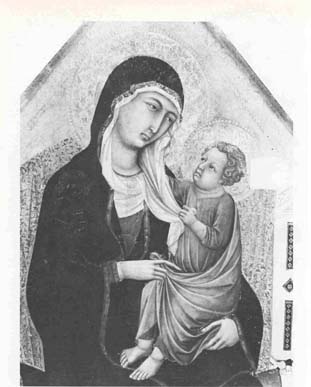

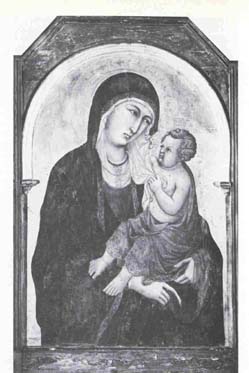
Ugolino di
Nerio: Saint Anne and the Virgin
by Laurence B. Kanter
Pages 1
| 2 | 3
| 4
| 5
| 6
| 7
From this point in his career, Ugolino's characters assume a stronger
dramatic flavour, probably under the increasing influence of Pietro Lorenzetti. He achieves also a stronger three-dimensionality, partly due to
more ambitious torsions in the design of his figures, partly to a greater
sensitivity to nuance in surface modelling and sfumato lighting effects.
Perhaps paradoxically, Ugolino exhibits at the same time a more exquisite
sense of pattern and linear refinement in place of his earlier concern with
simple shapes and volumes. The pictures in which this first becomes apparent
are the three surviving lateral panels from the Santa Croce alterpiece (fig.
6), now in Berlin, (18) and the almost contemporary Ricasoli polyptych (fig. 7)
at Brolio in Chianti. (19) In the latter it might be argued that only the
central Virgin and Child, the Baptist, and perhaps the Saint Peter are wholly
autograph. Only these panels reveal Ugolino's sophistication of handling as
well as his design, while the Saints John the Evangelist and Paul are less
inspired and drier in execution. In the centre panel, the Christ Child is
shown crossing His legs, with His robe falling across His thigh in remarkably
deep folds, more suggestive in their destiny and fluidity of the whorls in a
sea shell than of the behaviour of real cloth. He pulls at His mother's veil
with an energy that seems almost to pull her head down towards Him. The
Baptist and Saint Peter are the same dark, tense figures as in the Santa
Croce alterpiece. In both of these altarpieces, a simple arched panel shape
has been abandoned in favour of the more fashionable ogival arch. Both
altarpieces, furthermore, have introduced a complexity in the design of
haloes lacking in the earlier Polyptych 39 (fig. 5) at Siena. In the Berlin
panels (fig. 6), the rosette and leaf-shaped punches that were used in Siena
have been arranged to fill five concentric bands of decoration. At Brolio
(fig. 7) the artist reverted to three bands of decoration but expanded them
into more elegant and complex patterns reminiscent of the engraved designs of
his earliest haloes.
Another Saint John the Baptist, now at Poznan, (20) is easily
recognized as a slightly earlier version of the same figure in the Santa
Croce or Brolio altarpieces. He is cropped a little shorter at the waist,
his draperies are more simplified, and his left arm is drawn parallel to the
picture plane, where his later counterparts have more ambitiously
foreshortened arms and sharply turned wrists. The relative frontality of the
Poznan Baptist recalls the figures in Polyptych 39 at Siena, and the
smoother, more planar rendering of his facial features is more like that of
Saint Francis from Polyptych 39 than it is like the exaggerated detail of any
figure in the Santa Croce or Brolio altarpieces. Similar also to Polyptych 39
are the round arch of the Poznan panel, though in its present state it has been
slightly truncated, and the punched floral motifs against a stippled ground in the
halo.
The Poznan Baptist would appear to
occupy a chronological mid point between Polyptych 39 and the Santa Croce
altarpiece. This impression is confirmed by two other panels which may
be associated with it as parts of the same dismembered altarpiece. One
of these, a Saint Andrew in the collection of the J. Paul Getty
Museum in Malibu, Califomia (fig. 9), has long been recognized as belonging
with the Poznan panel. (21) In expression it approaches the dramatic intensity of the Santa Croce
saints, and like them Saint Andrew's halo is composed of five concentric
rings of geometric decoration. A third panel from this altarpiece, previously
unpublished, (22) represents a female saint holding a lily, possibly Saint
Eustochium (fig. 10). The condition of this panel, whose extensive and
crude repaints are apparent even in photograph, does not permit any stylistic
deductions beyond the observation that the figure repeats, almost literally,
the cartoon of an earlier figure of Saint Catherine by Ugolino,
now in Urbana, Illinois, at the Krannert Art Museum. (23) The panel with Saint
Eustochium (?) is almost exactly the same size as the Poznan and Oetty
panels and like them terminates in a rounded arch,
slightly truncated. The saint's halo, with a twisting vine running along
the centre, is a slightly more advanced form of those appearing in Polyptych
39, and makes use of the same rosette and three-petalled leaf punches employed
there, in the Santa Croce altarpiece (fig. 6), in the Ricasoli pentaptych
(fig. 7), and in the Ottawa Saint Anne. The pattern on Eustochium's
(?) robe is a variant of that on the dress of the young Virgin at Ottawa
or on the mantle of the Christ Child in the Tadini Madonna (fig. 3). (24)
The Getty / Poznan altarpiece is likely to shortly
predate those from Santa Croce and Brolio in Chianti. The picture that
must shortly postdate them now hangs behind the high altar of the Church
of the Misericordia at San Casciano (fig. II). The size and gabled shape
of this panel suggest that it was conceived as an independent image,
but it is flanked in the church today by two exactly contemporary panels
also by Ugolino, a Saint Francis and a Saint Peter (fig.
12) in half-length. (25) The gabled panel shows the Virgin, full-length,
seated on a throne of inlaid marble, with the Child supported on her left
arm and a donor kneeling before her at the right. The cartoon of the Child
is similar to that used earlier in the Tadini Madonna, but the treatment
of the figures is even more stylized than in the Brolio polyptych. The
sharp folds of the Child's cloak and tunic are resolved into pure pattern,
and both figures are delineated with a roundness and calligraphic exaggeration
unequalled in any previous picture, in fact surpassed in only one later:
the triptych from San Giovanni d'Asso (fig. 13), now part of the Contini-Bonacossi
bequest at the Palazzo Pitti in Florence. (26) In this last, the quality of
caricature latent beneath Ugolino's emotional sensitivity has been unleashed.
The decorative overstatement of every line - in folds of drapery, curls
of hair, or creases of skin - nearly obscures the underlying Ducciesque
inspiration. In the Palazzo Pitti today, Ugolino's San Giovanni d'Asso
triptych hangs opposite his Tadini Madonna in the same room. The
two Madonna and Child compositions are based on closely similar cartoons,
and were painted by the same artist, yet they seem worlds apart from each
other. The one is redolent of the grace and majesty of Duccio, the other
is as raucous as a work by the Ovile Master near mid-century. (27)
The Tadini Madonna and the San Giovanni
d'Asso triptych mark the poles of Ugolino's stylistic development. Where
in this long sequence does the Ottawa Saint Anne belong? The round
faces of both the mother and daughter and the Virgin's stylized curls and
elaborately patterned dress could only have been painted after the Brolio Madonna,
where in fact the pose of the child is repeated in that
of the Infant Christ, with His legs crossed and His right hand reaching
for His mother's veil. The two figures differ only in that the young Virgin
in Ottawa looks out to her left and brings her left arm further across
her body than does the Brolio Christ Child. (28) The fully modelled Saint
Anne strongly recalls the Madonnas from Brolio and San Casciano,
whose postures she echoes as well. Saint Anne's halo duplicates almost
exactly the design of that of the Madonna from San Casciano and,
finally, the San Casciano and Ottawa panels are, with one exception, the
only extant panels by Ugolino in which he decorated the margins of the
gold ground as well as the haloes with tooled punches.
Next Page | Saint Matthew in Robert
Lehman Collection
1
| 2 | 3
| 4
| 5
| 6
| 7
Annual Index | Author & Subject | Credits | Contact
This digital collection
was produced under contract to Canada's Digital Collections program,
Industry Canada.
"Digital
Collections Program, Copyright
© National Gallery of
Canada 2001"